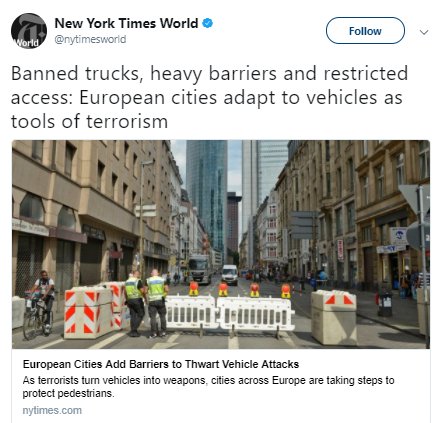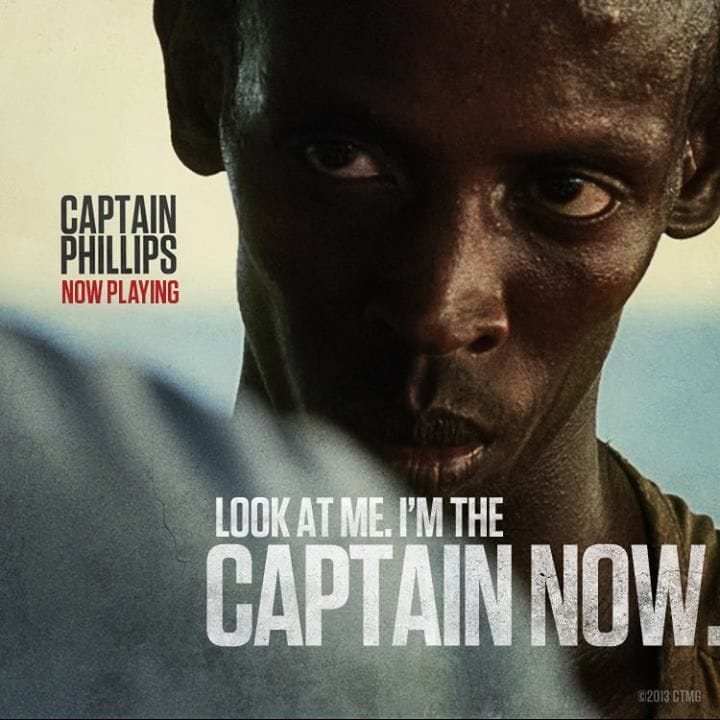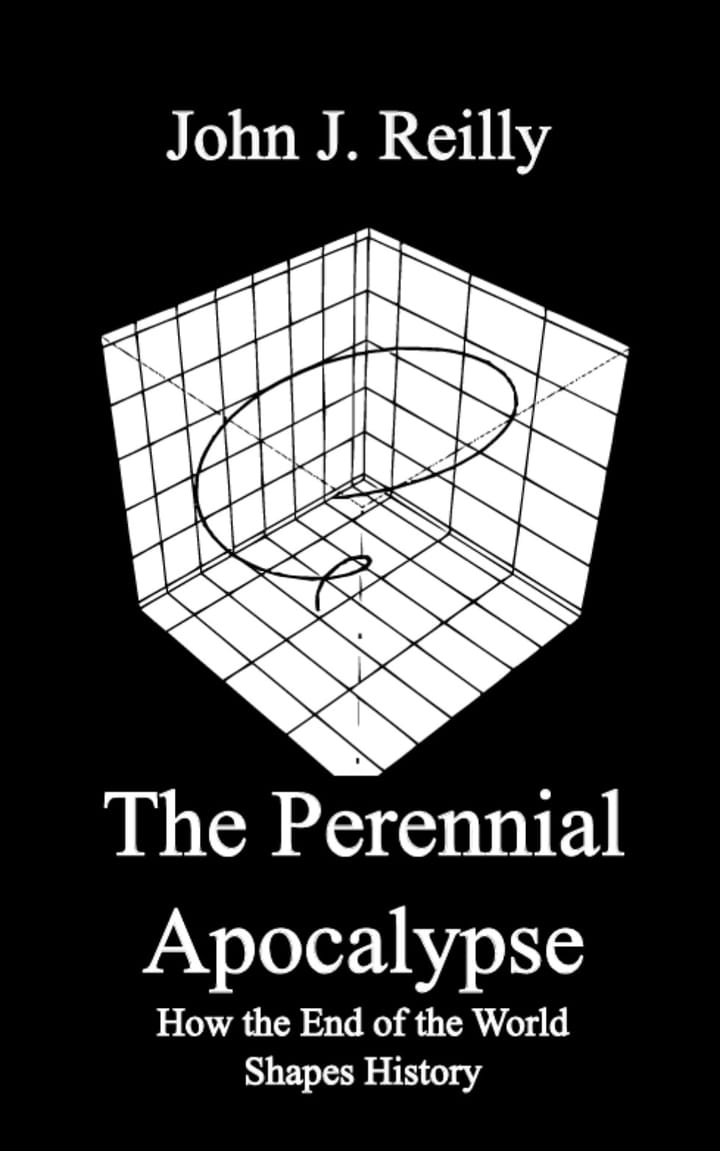The Long View: The West's Last Chance
In the years immediately after 9/11, ideas like the ones advanced by Tony Blankley in the the book under review were widely discussed. However, over time, people gradually lost interest in this kind of thing.
I find this fascinating. Some of the things Blankley advocated, such as a surveillance state, have come to pass. On the other hand, most Western nations have persisted in maintaining traditions of tolerance and openness, despite more than ten years of bombings, shootings, stabbings, and vehicular mayhem directed against the West and its people by Islamist terrorists.

In a sad way, this has simply become normal. But perhaps that isn't the worst thing that could have happened. Blankley advocated prosecuting the War on Terror with the ruthlessness of the Second World War. As a reminder of what that really looked like, the Allies had a policy of intentionally targeting civilians in both Europe and Japan, and were happy to impose a wide range of restrictions on resident aliens, naturalized citizens, and birthright citizens who shared a common ancestry with our Axis enemies.

The ruins of Dresden
By Bundesarchiv, Bild 183-Z0309-310 / G. Beyer / CC-BY-SA 3.0, CC BY-SA 3.0 de, https://commons.wikimedia.org/w/index.php?curid=5371503
So far, the West has resisted this. I suspect part of the reason is that once the shock of 9/11 wore off, it became clear that the kind of terrorism we see cannot possibly destroy any Western nation or its way of life. Asymmetric warfare lacks that kind of punch. For that to change, we would need to see at least an order of magnitude more attacks than we see now. From the data I have for the US, about 9 out of 10 terror plots are prevented by the police. It could be much worse.
The West’s Last Chance
Will We Win the Clash of Civilizations?
By Tony Blankley
Regnery Publishing, 2005
232 Pages, US$27.95
ISBN 0-89526-015-8
This review appeared in the
Spring 2006 issue of
Comparative Civilizations Review
The West is in an existential crisis says Tony Blankley, onetime speechwriter for Ronald Reagan and current editorial page editor for the Washington Times. The crisis is predicated on the loss of morale that began with the First World War, but occasioned by a transnational jihad launched against the West by a coalition of Islamists, the most dangerous of whom are based among the burgeoning Muslim populations in Western lands, particularly in Europe. Blankley is a naturalized American citizen of English origin; he has a lively sense that Churchill’s Britain was more completely mobilized than the Axis powers ever were. He proposes that the only way to defeat the jihad is for Western nations to employ the same ruthlessness and thoroughness that the Allies employed during the last civilizational crisis of the Second World War.
The West’s Last Chance presents a short but plausible brief (Blankley is also a lawyer) that touches dispassionately on all the key points: the nature of Islamist ideology; the demographic weakness of Europe; the relationship of jihad to culture war. Most interesting of all, perhaps, is that, though Blankley is usually accounted a conservative, he is not an American nationalist; neither is he a realist or a neo-isolationist. For that matter, he also is not a neoconservative universalist. The book speaks from a perspective that is still quite rare: the political and cultural unit he seeks to protect is the West, which at the least includes both America and Europe:
“The binding, traditions of language, religion, history, politics, foods, styles of life, and love of individual freedom are sufficient to form a lasting alliance between Americans and Europeans, from Boise to Budapest, from Chicago to Seville. The historic force of the Islamic insurgency, if nothing else, should hammer us back into a common sword that we can call the West.”
Blankley does not purport to be an expert on the Middle East or on Islam, but he has a sophisticated understanding of the Islamist movement. Its most important features are new: 20th century products of an ideological reaction against Western modernity. Before the foundation of Israel and long before the United States became a dominant factor in Middle Eastern politics, this reaction achieved formulation in the writings of Sayyid Qutb as a jeremiad aimed specifically at the United States. Another way that Islamism departs from the traditions of Islamic societies is that jihad, understood in a military sense, has become a personal duty; traditionally, it was a collective enterprise that could be launched only by competent religious authority.
Most important of all, the jihadists have removed the West, and particularly Europe, from the category of Dar al-Suhl, the land of truce, to the category Dar al-Harb, the land of war. The distinction is not theoretical, since there are now large and growing Islamic communities throughout Europe. Partly because of internal resistance, partly because of the ideology of multiculturalism, these communities are not integrating to their host countries. Those countries, one and all, have fertility rates below the replacement level. The term “Eurabia” has been coined to describe the Europe that would exist in the second half of this century if these trends continue: Here is Blankley’s most extreme statement of the danger:
“In an odd way, we are in a situation similar to that which confronted the American Indians when European explorers landed on their shores. From North America to South America, the Indians vastly outnumbered the intruders. But the Europeans were not exactly an army, and warfare did not exactly break out. Instead, both sides seemed almost friendly and cooperative at times. Had the Europeans been seen as a threat, the Indians could have slaughtered them in short order. Even with their guns, there were only a few hundred Europeans, while there were hundreds of thousands of Indians.”
An Islamic Europe, even a Europe merely cowed into diplomatic and cultural submission by large Muslim minorities, would be as intolerable a threat to the United States as a Nazi or a Soviet Europe would have been. However, as Blankley notes, present trends almost never do continue. He fully expects the demographic and cultural trends he describes to reverse.
Blankley does not discuss civilizational dynamics in detail. He does, however, obviously favor some models over others. To begin with, he has little regard for any analysis that likens the current condition of the West to that of the later Roman Empire:
“The history of a nation, people, or a civilization is not linear; nor is it a predictable cycle in the sense that a nation arises, becomes vigorous and develops its classic form, then succumbs to excess, then decadence, and finally death. Such intellectual constructs are too neat. They are often historically contradicted. China has repeatedly emerged from decadence back to youthful vigor, as she is doing currently.”
Without citing him, Blankley embraces Toynbee’s model of broad historical trends that contextualize rather than eliminate free will: “Challenge and response, not continuity, describe the progress of human affairs.” However, the metahistorians whom Blankley most sounds like are Neil Strauss and William Howe, who devised a popular model of American history based on cycles of generations. In this book, the model is applied more broadly:
“The cycle [today] would seem to be completing itself as it so often does in human history. Victory [in 1945], delivered by certain values, yielded prosperity that permitted individualistic caprice, indulgence, overconfidence, excess, and a lack of a joint study permitted danger to arise again and calls for certain values to overcome. As the [baby] boomers were present at the inception of the prosperity and safety cycle, so they will be present at the end of the cycle in the beginning of the danger-driven renewal.”
By the end of the Second World War, Blankley explains, it seemed that the traditional patriotism and cultural pride of Western countries had been discredited. Even to suggest that one’s own society had features that deserved to be preserved was to risk the danger of being branded a chauvinist and a racist, in part for the excellent reason that chauvinists and racists did say things like that. To the extent that people thought about the birthrate at all, it was to devise ways of lowering it.
And so, with great good will, and with considerable success, the leading spirits of Europe set about to create a cosmopolitan society, a continent without borders, in which justice and plenty would be provided by rational, secular administration; and no culture would be preferred to another. All these plans rested on a flawed assumption, however:
“The linchpin of this entire gorgeous edifice -- now already 2/3 constructed -- was an ever-growing, assimilated, law-abiding Muslim European population. Only a steady tide of high-birthrate Muslims could fill the ever-expanding population gap caused by the dearth of indigenous European babies. Only with these young increasingly productive Muslim workers could Europe afford the social welfare system it had given itself. Only with these able and law-abiding workers could Europe economically compete with America and Asia in the 21st century and beyond.”
This is not going to happen. Neither, probably, will Eurabia happen. One of two things will stop it. Western elites might understand the magnitude of their peril and take the sort of steps to meet it that Blankley discusses in the second half of his book. The other possibility is that native European populations will take matters into their own hands, leading to an age of ethnic cleansing and civil war.
According to Blankley, 2004 was the decisive year. The slaughter of the school children in Beslan; the train-bombings in Madrid; and most of all, the gruesome murder of Dutch filmmaker Theo van Gogh: these events demonstrated to high and low alike that universalist Europe had failed. Blankley gives hopeful coverage to evidence that elite opinion, and even fashionable opinion, is turning against the ideology of multiculturalism. Members of the Green parties, for instance, have taken to demonstrating against the traditional celebration of the feast of Eid al-Adha, because it involves the slaughter of lambs and goats. Even the French establishment, so quick to cater to supposed Muslim sentiment in diplomatic matters, now seems determined to hold fast against the intrusion of Islam into the public square, lest the French tradition of laicism be undermined.
This brings us to the question of religion in the West, and what role it might play in defeating the Islamist threat. At one point, Blankley states, “The West needs to recover its fighting faith.” That is plausible, but Blankley’s treatment of the matter recalls the apocryphal saying of Dwight Eisenhower that American society rested on a strong religious faith and he did not give a damn which one it was.
Blankley notes the statistical correlation between high levels of religious practice and those cultural traits that he believes the West needs to survive, such as fertility rates above the replacement level, patriotism, and a capacity for moral outrage. He also observes that the widely noted difference between America and Europe in the level of religious belief is probably not as great as is generally thought. The real difference is that public agnosticism is expected among elites in much of Europe (one thinks of Prime Minister Blair skulking off to Catholic Mass when no one is looking), whereas a show of piety is good form most of the United States. He points out that some of the strongest opposition to Islamicism now comes from secularists. On the other hand, he also points out that secularism is a historical anomaly, and may not be sustainable in any case.
There are grounds for expecting a religious revival, he says. If, as seems likely, the immediate future resembles the troubled years between 1914 and 1945, then the sheer growth in hardship could drive people to spiritual comfort. He also cites, without evaluation, some speculation by neurologists that religion may be hardwired into the brain, and so will always reassert itself. Frankly, if this the kind of consideration comes to underlie the Western assessment of the value of religion, then it seems to me that the chance for a general revival is nil. Faith defines need. A faith that is invoked to serve a need is really just a Sorelian myth.
Whatever the spiritual state of the West, hardships there will certainly be, many of them necessarily self-imposed. We are entering an era, he suggests, in which economic efficiency will not be the governing criterion in international relations:
“Eventually it will dawn on Western leaders and public opinion that it would be safer to keep some distance between the West and Islam. Everything from Internet connections to immigration, to tourism, to business, to trade will be more carefully controlled if not partially disconnected. Each restraint on the free flow of people, material, and words will act to marginally damage our economies.”
Even more important, the liberal West must recognize that, in Oliver Wendell Holmes’s words, “The Bill of Rights is not a suicide pact,” and that survival is the first right:
“It is increasingly likely that such a threat cannot be defeated while the West continues to adhere to its deeply held values -- as it currently understands them -- of tolerance, the right to privacy, the right even to advocate sedition, and the right to equal protection under the law. The day is upon us when the West will have to decide which it values more: granting these rights and tolerance to those who wish to destroy us, or the survival of Western civilization. And this is another reason the West has been slow to react -- because reacting violates its own values.”
Blankley recalls at length just how willing the Allied governments during World War II were willing to subject classes of people to special security measures. The internment of American citizens of Japanese origin is the best-known example, but even larger numbers of other ethnic groups were affected. Many were forced to move or sell their property. Aliens from enemy countries were often deported; naturalized citizens sometimes lost their citizenship. Blankley recites this history without deploring it. The beginning of wisdom, he suggests, is precisely to embrace the practice of ethnic profiling.
Neither can the governments of the West, and particularly the government of the United States, afford any longer to be equally tolerant of all religions. He recalls a Supreme Court decision from 1940 that approved the expulsion of the children of religious sectarians from school because the children refused to recite the Pledge of Allegiance. (Note that this was before the Pledge contained the words “under God,” the occasion of current legal attacks on the Pledge.) The Court was not impressed by the fact that the families of the children belonged to a denomination that refused to swear allegiance to any secular government. For the Court, the government was well within its rights in insisting that schools instill loyalty and a sense of national unity among school children. If Blankley has his way, government will soon again insist on no less.
The book makes other proposals, among the least extreme of which is that serious security measures cannot be implemented without the creation of a national identity card. That would be part of a larger process of internal surveillance that would include taking effective control of the borders. Presumably, the need to track aliens in the country would also rule out a guest-worker program of any great size. The most conceptually interesting proposal, however, is for a declaration of war.
Blankley does not often criticize the Bush Administration in detail, but he deplores its failure to articulate what the war is about. It’s not a war on terror. It’s not a war on Islam. It’s a war on Islamists who seek to subvert the governments of the West and coerce their policies through terror. A declaration of war would clarify the matter. It would also allow the sort of emergency regime that obtained during the 20th century world wars to take effect. Blankley is aware that liberty would not prosper if the measures he is proposing became normal. That is why he suggests that the declaration of war contain a sunset provision. Congress might consider every two years, for instance, whether to renew the declaration. That would be oversight enough.
As we saw at the beginning of this review, the project that Blankley proposes is by no means a conservative enterprise. In effect, he is laying the foundation for a new patriotism, to the nation of the West, on whose survival all the historical patriotisms of France and Holland and Germany and America depend. This is a real conceptual problem with the book: if a revival of patriotism is one of the things that are necessary to fight off the Islamist challenge, then how can one characterize the campaign in terms of the defense of the West as a whole? Nonetheless, we see here an outline of a formidable engine, one that could, conceivably, fulfill the function for which it was designed. The one great deficiency is that the engine still lacks the fuel of fear that is necessary to make it go. Blankley is aware of that, but does not doubt that events will supply it. After all, last year the murder of a single Dutch filmmaker (and a rather disreputable one at that) wonderfully concentrated the mind of all Europe. What might a serious string of suicide bombings do, much less a manmade plague, or a nuke?
Copyright © 2005 by John J. Reilly

The West's Last Chance: Will We Win the Clash of Civilizations? By Tony Blankley



Comments ()